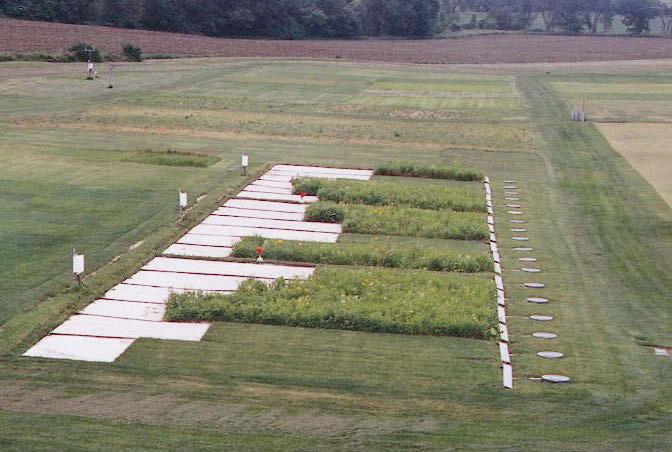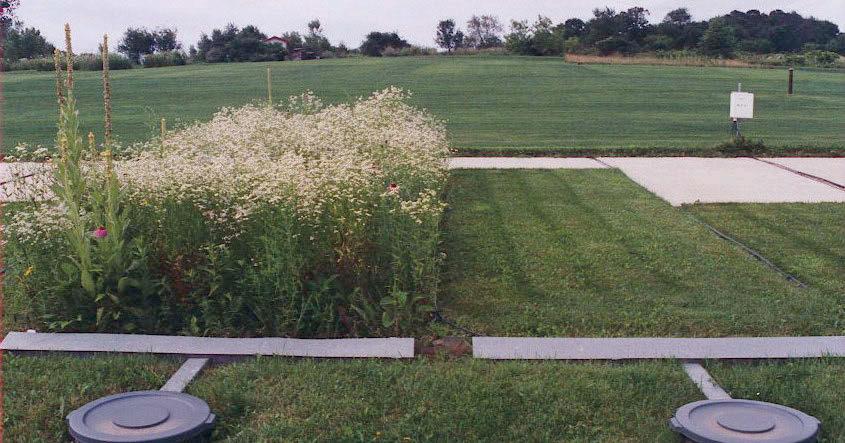
6 minute read
Rooted in Research—Buffer Strips: How Well Do They Reduce Nutrient and Sediment Loading and Does the Species Composition Matter?
ROOTED IN RESEARCH
BUFFER STRIPS: HOW WELL DO THEY REDUCE NUTRIENT AND SEDIMENT LOADING AND DOES THE SPECIES COMPOSITION MATTER?
By Cale A. Bigelow, PhD
Welcome back to Rooted in Research, where we take a deep dive into timely and topical turf research. It’s been a few issues since I have had the chance to share some turf research findings, but the column has been in good hands with my trusted colleague and “The King of Rings,” Dr. Mike Fidanza, who kept everyone up to date on all things turfgrass.
For this installment I wanted to dig into some more soil science research and the efforts of my colleagues to develop best management practices that minimize sediment and nutrient loss from managed turf systems. For this article, I am highlighting some of the important ecological work that was conducted by Dr. Kurt Steinke under the direction of Dr. Wayne Kussow and Dr. John Stier at The University of Wisconsin to evaluate various buffer strip systems for their ability to filter runoff water.
The Problem
Back in the early 2000s, the subject of nutrient enrichment of streams, rivers, and lakes was quite the legislative hotbutton issue (as it still is today). Personally, I can’t imagine anyone caring for the turfgrass and the environment that does not want to preserve and protect water quality but there are policymakers that might disagree.
Thus, across the United States, a number of states put in place a variety of ordinances and laws intended to reduce nutrient enrichment from “the built environment” including turfgrasses. Further, federal mandates to decrease nutrient pollution (e.g., nitrogen (N) and phosphorus (P)) have been aimed at reducing P movement into surface waters and N movement into groundwater for many years.
Although P normally binds tightly to soil particles it only takes a very small quantity of this nutrient to cause nutrient enrichment in freshwater lakes and streams. Under the right environmental conditions nutrient enrichment eventually leads to eutrophication where water oxygen levels decrease which in turn impair the ability of fish and other marine life to thrive and survive.
The problem is that the exact sources of P that may contribute to eutrophication are unclear, but excess phosphate fertilizers have been implicated, and since P is tightly adsorbed to soil particles, any movement of bare soil may also contribute to nutrient enrichment.
With regard to N and leaching, excess application and/or downward movement can result in contaminated drinking water supplies. This is especially important to avoid where a community is reliant on well water supplies. Regardless, we still come back to one of the fundamental lessons in managing turfgrass, “employ cultural practices that promote a dense, healthy turf.” This simple rule of thumb allows for maximum retention of precipitation and irrigation as well as minimizing any sediment/nutrient movement.
With this in mind, I can understand why policymakers in states like Wisconsin were acutely interested in doing everything they could to protect water quality, including suggestions or requirements for buffer strips adjacent to any body of water. Unfortunately for the turfgrass industry, at the time there was not a whole lot of research data that documented and demonstrated differences in the possible quantity of nutrient and sediment loss coming from managed areas like turfgrass.
There was abundant information from many traditional production agricultural systems but little information for how things might happen in a built environment like a neighborhood that contains hardscape (e.g., asphalt, concrete, etc.) and turfgrass. Further, there was a mindset
that “native prairie” areas, or in other words, unmowed areas dominated by herbaceous forb-type plants, might be superior to mowed turf areas. The logic being that these native prairies are a superior choice because the plant materials are native to a particular region as compared to turfgrass plants that were imported from Eurasia many years ago. Lastly, prairies are rarely mowed or fertilized which possibly translates to lower overall maintenance costs.
The Research
A series of studies were conducted, and results published that evaluated various aspects of the utility and effectiveness of turfgrass versus prairie vegetation. For the sake of this article, I want to highlight an article published by Steinke et al. in 2007 entitled: “Prairie and turf buffer strips for controlling runoff from paved surfaces” and published in the Journal of Environmental Quality 36:426-439.
In this multi-year field study, Kentucky bluegrass and prairie mixes were seeded into rectangular plots on a siltloam soil that had a roughly 5 percent slope. In addition to the rectangular plots, there were various pervious (e.g., plant material) and impervious (concrete) ratios evaluated. Impervious surface was installed on the upslope end of each plot to provide 1:1, 1:2, and 1:4 impervious and pervious surface ratios. At the bottom of the downslope, a collector was installed to collect all runoff water moving across each plot (See Figure 1). For two growing seasons the plot runoff was monitored and analyzed for total volume, total suspended solids and organic suspended solids, total P, soluble and organic P, and bioavailable.
What did they find?
The average runoff volumes and all types of mean annual sediment and P nutrient losses were not significantly different between Kentucky bluegrass and prairie vegetation. They also noted that in a climate like Madison, WI, where the ground freezes for an extended period of time, roughly 80 percent of the plot runoff occurred during frozen soil conditions, much of the rest infiltrated into the soil during the growing season. They noted that vegetation type was a likely contributor to nutrient loss during winter runoff especially since the prairie vegetation was dormant and plants had died back to the ground resulting in roughly 50 percent less cover during this time period. Further, these senesced plant parts (e.g., leaves, stems, etc.) and any nutrients leaching out of the decaying plant material may be subject to movement with runoff water. When runoff occurred during non-frozen soil conditions, the Kentucky bluegrass turf allowed for significantly lower runoff volumes compared to prairie vegetation. This is most likely due to the much higher shoot density and full canopy of the turfgrass versus the prairie vegetation. Lastly, they noted that while runoff did occur in both of the systems tested, that the sediment and P losses from both this immature prairie and Kentucky bluegrass turf were an order of magnitude less when compared to published values for some agricultural production systems and construction sites. That final take-home point the authors suggest is for urban designers and planners. Based on these study data, where runoff and nutrient enrichment is of high importance, designers should prevent runoff during winter conditions from directly entering surface waters. In summary, this study supports what has been said before; “managed properly, a well-maintained turf is an environmental asset.” Turfgrass provides aesthetic beauty and functions equal to or better than many alternative vegetation options where the desire is to preserve and protect water quality. With that I will leave you all to enjoy these late-summer and autumn months, please remember to be responsible with any nutrients you are applying. And I will begin to look for another timely turfgrass topic for the next Rooted in Research article. Be well!

Figure 1: Overview of runoff plots with varying ratios of pervious and impervious surfaces and Kentucky bluegrass or native prairie vegetation.
Overview of the runoff plots containing Kentucky bluegrass or native prairie vegetation at the University of Wisconsin O.J. Noer Research facility.

Cale A. Bigelow, PhD, is a professor of Turfgrass Science and Ecology in the Department of Horticulture and Landscape Architecture at Purdue University in Indiana. Mike Fidanza, PhD, is a professor of Plant and Soil Science at Pennsylvania State University, Berks Campus. They are teaming to provide a Rooted in Research article for each issue of Turf News. ersity, arch










